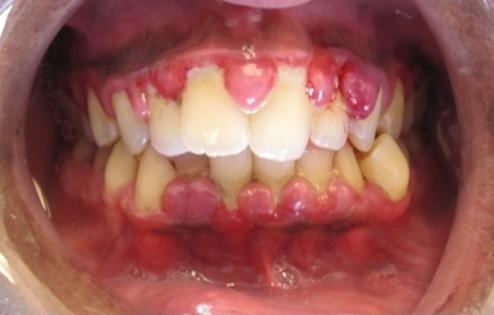Specialty gastroenterology | ICD-10 K06.1 (ILDS K06.100) | |
 | ||
Gingival enlargement, (also termed gingival overgrowth, hypertrophic gingivitis, gingival hyperplasia, or gingival hypertrophy, and sometimes abbreviated to GO), is an increase in the size of the gingiva (gums). It is a common feature of gingival disease. Gingival enlargement can be caused by a number of factors, including inflammatory conditions and the side effects of certain medications. The treatment is based on the cause. A closely related term is epulis, denoting a localized tumor (i.e. lump) on the gingiva.
Contents
Classification
The terms gingival hyperplasia and gingival hypertrophy have been used to describe this topic in the past. These are not precise descriptions of gingival enlargement because these terms are strictly histologic diagnoses, and such diagnoses require microscopic analysis of a tissue sample. Hyperplasia refers to an increased number of cells, and hypertrophy refers to an increase in the size of individual cells. As these identifications obviously cannot be performed with a clinical examination and evaluation of the tissue, the term gingival enlargement is more properly applied. Gingival enlargement has been classified according to etiology into 5 general groups:
Inflammatory enlargement
Gingival enlargement may be caused by a multitude of causes. The most common is chronic inflammatory gingival enlargement, when the gingivae are soft and discolored. This is caused by tissue edema and infective cellular infiltration caused by prolonged exposure to bacterial plaque, and is treated with conventional periodontal treatment, such as scaling and root planing.
Gingivitis and gingival enlargement are often seen in mouth breathers, as a result of irritation brought on by surface dehydration, but the manner in which it is caused has not been demonstrated.
The accumulation and retention of plaque is the chief cause of inflammatory gingival enlargement. Risk factors include poor oral hygiene, as well as physical irritation of the gingiva by improper restorative and orthodontic appliances.
Drug-induced enlargement
This type of gingival enlargement is sometimes termed "drug induced gingival enlargement" or "drug influenced gingival enlargement", abbreviated to "DIGO". Gingival enlargement may also be associated with the administration of three different classes of drugs, all producing a similar response: Gingival overgrowth is a common side effect of phenytoin, termed "Phenytoin-induced gingival overgrowth" (PIGO).
Of all cases of DIGO, about 50% are attributed to phenytoin, 30% to cyclosporins and the remaining 10-20% to calcium channel blockers.
Drug-induced enlargement has been associated with a patient's genetic predisposition, and its association with inflammation is debated. Some investigators assert that underlying inflammation is necessary for the development of drug-induced enlargement, while others purport that the existing enlargement induced by the drug effect compounds plaque retention, thus furthering the tissue response. Careful attention to oral hygiene may reduce the severity of gingival hyperplasia. In most cases, discontinuing the culprit drug resolves the hyperplasia.
Enlargement associated with systemic factors
Many systemic diseases can develop oral manifestations that may include gingival enlargement, some that are related to conditions and others that are related to disease:
Management
The first line management of gingival overgrowth is improved oral hygiene, ensuring that the irritative plaque is removed from around the necks of the teeth and gums. Situations in which the chronic inflammatory gingival enlargement include significant fibrotic components that do not respond to and undergo shrinkage when exposed to scaling and root planing are treated with surgical removal of the excess tissue, most often with a procedure known as gingivectomy. A gingivectomy can be performed with a scalpel blade, or by a CO2 laser to achieve minimal blood loss and reduced discomfort for patients.
In DIGO, improved oral hygiene and plaque control is still important to help reduce any inflammatory component that may be contributing to the overgrowth. Reversing and preventing gingival enlargement caused by drugs is as easy as ceasing drug therapy or substituting to another drug. However, this is not always an option; in such a situation, alternative drug therapy may be employed, if possible, to avoid this deleterious side effect. In the case of immunosuppression, tacrolimus is an available alternative which results in much less severe gingival overgrowth than cyclosporin, but is similarly as nephrotoxic. The dihydropyridine derivative isradipidine can replace nifedipine for some uses of calcium channel blocking and does not induce gingival overgrowth.
Epidemiology
Gingival enlargement is common.
Other animals
It is commonly seen in Boxer dogs and other brachycephalic breeds, and in the English Springer Spaniel. It usually starts around middle age and progresses. Some areas of the gingiva can become quite large but have only a small attachment to the rest of the gingiva, and it may completely cover the teeth. Infection and inflammation of the gingiva is common with this condition. Under anesthesia, the enlarged areas of gingiva can be cut back with a scalpel blade or CO2 laser, but it often recurs. Gingival enlargement is also a potential sequela of gingivitis. As in humans, it may be seen as a side effect to the use of ciclosporin.
